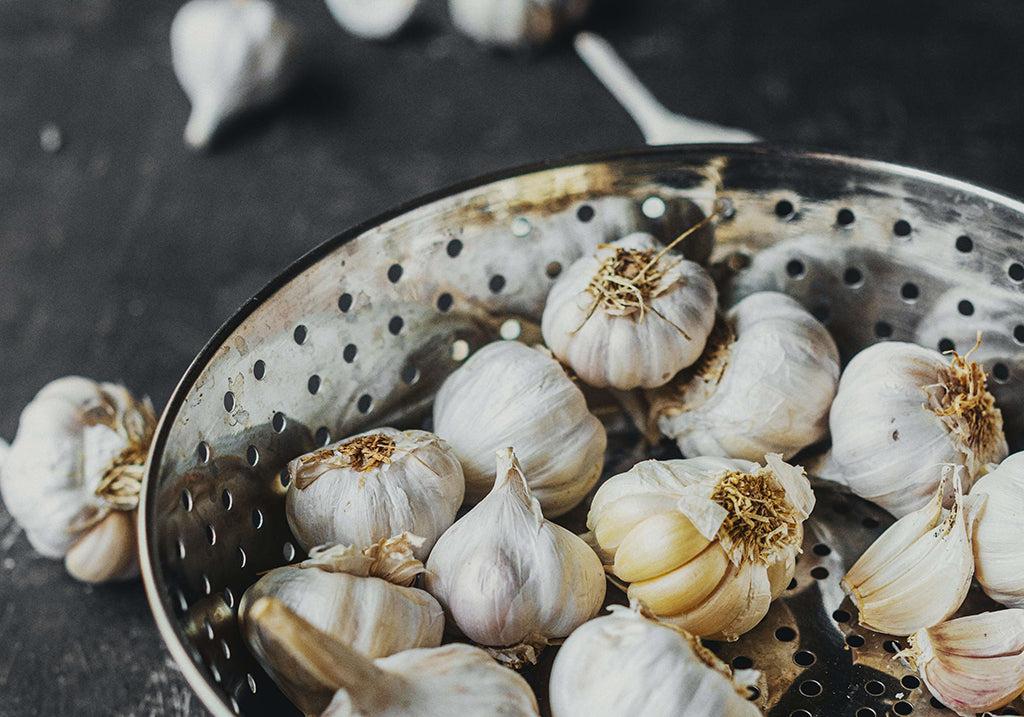In this blog, we look at whether dogs can eat garlic, if it’s good or bad for them and how to spot the signs and symptoms of garlic poisoning. Read more to answer the question, “can dogs eat garlic?”
Garlic: Is It Safe For Your Dog To Eat?

Garlic; the smell alone can make someone either salivate or turn their nose up! It’s a very common addition to some of our favorite recipes, regularly added to sauces, and also often found in nutritional studies due to the natural medical benefits it can offer us humans.
However, can this versatile and aromatic vegetable offer your pup the same wonderful benefits?
Is Garlic Safe For Dogs To Eat?
Well, if garlic is good for humans, it should be okay for our dogs to eat too, right? The answer isn’t that simple. In large amounts, garlic can be toxic to dogs. You see, our pups metabolize some foods differently from us – and garlic falls under that category.
Garlic is a member of the Allium family, along with onions, chives, and leeks, which means they contain thiosulfate; an incredibly toxic chemical for dogs and could cause serious illness or even fatality.
Can Dogs Eat Garlic Bread?
Let’s face it, if you’re a garlic lover, chances are you’re a big fan of garlic bread (myself included). The smell, the delicious melted garlic butter, the crunchy bread – it’s all just very mouth-watering… So, imagine how your pup must feel when they catch a whiff of this appetizing smell!
Well, realistically we can assume garlic bread is off-limits as it contains garlic, but it actually hosts a plethora of other ingredients that could cause problems for your hungry pooch, too. Butter, herbs, cheese, and large amounts of oil can upset your pup’s stomach and digestive system. Not to mention the high volume of calories and fats packed into garlic bread – this human food offers little to no nutritional or health benefits to your furry friend.

How Much Garlic Can A Dog Eat?
Now, this is where things can get a little confusing…
Garlic is actually an ingredient in some supplements for dogs! Many pet parents and experts have debated over garlic being beneficial to the canine digestive and immune system – providing similar health benefits that it offers us humans.
While small amounts of garlic (often found in these pet health supplements) may be safe, some dogs are more sensitive to garlic toxicity, which is why a lot of pet experts will suggest you should try to avoid giving your dog anything with garlic in, as you don’t know how your pup’s body will react – it’s just not worth the risk!
If you want to give your pup a supplement with garlic in the ingredients, please consult your veterinarian before adding it to their diet.
What Is Garlic Poisoning In Dogs?
As mentioned above, garlic is a member of the Allium family, which means they contain thiosulfate which is toxic to dogs. But, what does thiosulfate do to dogs? Well, unfortunately, thiosulfate can cause oxidative damage to your dog’s red blood cells, which can lead to hemolytic anemia. When red blood cells are damaged, they cannot perform their job correctly, meaning they won’t be able to carry oxygen around your dog’s body. With less oxygen reaching vital organs and tissues, your dog’s health will suffer.
According to a study from the US National Library of Medicine National Institutes of Health, it can take around 15g to 30g of garlic per kilogram of body weight to produce harmful and potentially deadly changes to your dog’s blood.
Not to mention, garlic poisoning can cause a multitude of gastrointestinal issues, and, in some cases, death. This is why it is so important for us pet parents to know the symptoms and signs of garlic poisoning…
Symptoms of Garlic Poisoning
Depending on the amount of garlic your dog has ingested and the breed/size of your pup, symptoms of garlic poisoning can vary in severity. Take a look at some of the most common symptoms;
- Abdominal pain, tenderness, or cramping
- Foul breath
- Blood in urine
- Diarrhea
- Vomiting
- Extreme tiredness
- Yellow skin/eyes
- Weak muscles
- Excessive drooling
- Pale gums
- Seizures
- Collapse
- Rapid heart rate
- Difficulty breathing
How To Treat Garlic Poisoning
If your pup is showing any of the signs above, you must get to your veterinarian as soon as possible. If these symptoms are due to garlic poisoning, your veterinarian will administer charcoal to induce vomiting and rid them of the toxins. If this is unsuccessful, your veterinarian may admit your dog and perform a different procedure involving saline solution, IV fluids, and oxygen therapy. In very bad cases, your dog may need a blood transfusion.
Now, although garlic poisoning is a very serious issue, if you act fast and seek medical support, your dog should be able to make a full recovery.
Curious about what other foods are toxic to dogs? Read our blog on 5 other common foods that are toxic to dogs here and check out our handy PetLab Co. guide below that details the known foods that are dangerous for dogs to consume…

Sources
Author Kovalkovičová, Natália DVM., PhD, “Some Food Toxic For Pets”, Sep 28. 2009, US National Library of Medicine National Institue of Health https://www.ncbi.nlm.nih.gov/pmc/articles/PMC2984110/
Author Sanderson, Sherry BS, DVM, PhD, DACVIM, DACVN, “Nutritional Requirements and Related Disease of Small Animals”, Sep 2013, MSD Manual Veterinary Manual, https://www.msdvetmanual.com/management-and-nutrition/nutrition-small-animals/nutritional-requirements-and-related-diseases-of-small-animals
 B
B



